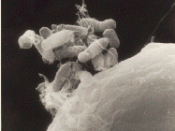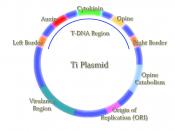Genetic modification allows plants to be produced with specific qualities more accurately and efficiently than through traditional methods such as cross-breeding to produce hybrid plants1. Through cross-breeding, large amounts of genetic material are passed between plant varieties. This makes it more difficult to develop specific characteristics without incorporating other unwanted ones, such as susceptibility to disease2. GM technology is being developed to create crops with characteristics such as added nutritional value, herbicide tolerance, and pest resistance3.
Plants have a great practical advantage over animals in terms of their suitability for genetic modification. Their cells are totipotent, i.e. they have the potential to become any other cell in the plant, and you are able to regenerate an entire plant from a single cell4. There are many methods used to insert genes into plants, the two main ones being soil bacteria and the gene gun. The 'gene gun' or 'biolistics' method can be used with all plant species, but is used mainly with cereals.
Tiny gold or tungsten particles, coated with DNA, are fired into plant tissue5. The most common method of transferring genes to plant cells is to use Agrobacterium tumefaciens. In nature this soil bacterium infects plants and causes tumors called crown galls. The tumors are induced by a plasmid in the bacterium called the Ti plasmid, which has the ability to invade plant tissue and insert part of the plasmid (called T-DNA) into the plant genome. Scientists have been able to delete the gene necessary for gall formation while retaining the genes needed to infect host cells. To insert a new gene into the plant genome, the new gene, and a gene coding for resistance to a certain antibiotic, can be engineered into the Ti plasmid within the T-DNA region. The modified plasmid is then transferred into the...


